Relationship between the True Digestibility of Dietary Calcium and Gastrointestinal Microorganisms in Goats
Simple Summary
Abstract
1. Introduction
2. Materials and Methods
2.1. Animals and Sampling
2.2. Analysis of Samples and Grouping
2.3. DNA Extraction and Amplification
2.4. Bioinformation Analysis
2.5. Statistical Analysis
3. Results
3.1. The TDC of Goats
3.2. Plasma Biochemical, Ruminal Fermentation and Nutrient Apparent Digestibility Indices
3.3. Data Acquired from Sequencing
3.4. Alpha Diversity and Beta Diversity Analysis
3.5. Bacterial Composition of the GIT
3.6. Comparisons of Bacterial Composition between HC and LC Group
3.7. Correlation between the TDC and the Bacterial Composition across the GIT
4. Discussion
5. Conclusions
Author Contributions
Funding
Conflicts of Interest
References
- Mackie, R.I.; White, B.A. Recent Advances in Rumen Microbial Ecology and Metabolism: Potential Impact on Nutrient Output. J. Dairy Sci. 1990, 73, 2971–2995. [Google Scholar] [CrossRef]
- Russell, J.B.; Rychlik, J.L. Factors That Alter Rumen Microbial Ecology. Science 2001, 292, 1119–1122. [Google Scholar] [CrossRef] [PubMed]
- Wang, L.; Liu, K.; Wang, Z.; Xue, B.; Peng, Q.; Jin, L. Bacterial community diversity associated with different utilization efficiencies of nitrogen in the gastrointestinal tract of goats. Front. Microbiol. 2019, 10, 239. [Google Scholar] [CrossRef] [PubMed]
- Thompson, J.K.; Gelman, A.L.; Weddell, J.R. Mineral retentions and body composition of grazing lambs. Anim. Sci. 1988, 46, 53–62. [Google Scholar] [CrossRef]
- Stein, H.H.; Adeola, O.; Cromwell, G.L.; Kim, S.W.; Mahan, D.C.; Miller, P.S. Concentration of dietary calcium supplied by calcium carbonate does not affect the apparent total tract digestibility of calcium, but decreases digestibility of phosphorus by growing pigs. J. Anim. Sci. 2011, 89, 2139–2144. [Google Scholar] [CrossRef]
- González-Vega, J.C.; Walk, C.L.; Liu, Y.; Stein, H.H. The site of net absorption of calcium from the intestinal tract of growing pigs and effect of phytic acid, calcium level and calcium source on calcium digestibility. Arch. Anim. Nutr. 2014, 68, 126–142. [Google Scholar] [CrossRef]
- Liu, J.; Bollinger, D.W.; Ledoux, D.R.; Veum, T.L. Lowering the dietary calcium to total phosphorus ratio increases phosphorus utilization in low-phosphorus corn-soybean meal diets supplemented with microbial phytase for growing-finishing pigs. J. Anim. Sci. 1998, 76, 808–813. [Google Scholar] [CrossRef]
- Young, V.R.; Richards, W.P.C.; Lofgreen, G.P.; Luick, J.R. Phosphorus depletion in sheep and the ratio of calcium to phosphorus in the diet with reference to calcium and phosphorus absorption. Br. J. Nutr. 1966, 20, 783–794. [Google Scholar] [CrossRef]
- Sambrook, I.E. Studies on digestion and absorption in the intestines of growing pigs. Br. J. Nutr. 1978, 39, 515–526. [Google Scholar] [CrossRef]
- Huang, H.; Zhang, R.; Fu, D.; Luo, J.; Li, Z.; Luo, H.; Shi, P.; Yang, P.; Diao, Q.; Yao, B. Diversity, abundance and characterization of ruminal cysteine phytases suggest their important role in phytate degradation. Environ. Microbiol. 2011, 13, 747–757. [Google Scholar] [CrossRef]
- Nakashima, B.A.; McAllister, T.A.; Sharma, R.; Selinger, L.B. Diversity of Phytases in the Rumen. Microb. Ecol. 2007, 53, 82–88. [Google Scholar] [CrossRef] [PubMed]
- Ammerman, C.B.; Forbes, R.M.; Garrigus, U.S.; Newmann, A.L.; Norton, H.W.; Hatfield, E.E. Ruminant Utilization of Inorganic Phosphates. J. Anim. Sci. 1957, 16, 796–810. [Google Scholar] [CrossRef]
- Alonso, V.; Cavaglieri, L.; Ramos, A.J.; Torres, A.; Marin, S. Modelling the effect of pH and water activity in the growth of Aspergillus fumigatus isolated from corn silage. J. Appl. Microbiol. 2017, 122, 1048–1056. [Google Scholar] [CrossRef] [PubMed]
- AOAC (Association of Official Analytical Chemists). Official Methods of Analysis, 15th ed.; AOAC International: Arlington, VA, USA, 2011. [Google Scholar]
- Julák, J.; Stránská, E.; Procházková-Francisci, E.; Rosová, V. Blood cultures evaluation by gas chromatography of volatile fatty acids. Med. Sci. Monit. 2000, 6, 605–610. [Google Scholar] [PubMed]
- Meschy, F. Recent progress in the assessment of mineral requirements of goats. Livest. Prod. Sci. 2000, 64, 9–14. [Google Scholar] [CrossRef]
- Nkrumah, J.D.; Okine, E.K.; Mathison, G.W.; Schmid, K.; Li, C.; Basarab, J.A.; Price, M.A.; Wang, Z.; Moore, S.S. Relationships of feedlot feed efficiency, performance, and feeding behavior with metabolic rate, methane production, and energy partitioning in beef cattle. J. Anim. Sci. 2006, 84, 145–153. [Google Scholar] [CrossRef]
- Ramos, M.H.; Kerley, M.S. Mitochondrial complex I protein differs among residual feed intake phenotype in beef cattle. J. Anim. Sci. 2013, 91, 3299–3304. [Google Scholar] [CrossRef]
- Guo, W.; Li, Y.; Wang, L.; Wang, J.; Xu, Q.; Yan, T.; Xue, B. Evaluation of composition and individual variability of rumen microbiota in yaks by 16S rRNA high-throughput sequencing technology. Anaerobe 2015, 34, 74–79. [Google Scholar] [CrossRef]
- Caporaso, J.G.; Lauber, C.L.; Walters, W.A.; Berg-Lyons, D.; Lozupone, C.A.; Turnbaugh, P.J.; Fierer, N.; Knight, R. Global patterns of 16S rRNA diversity at a depth of millions of sequences per sample. Proc. Natl. Acad. Sci. USA 2011, 108 (Suppl. 1), 4516–4522. [Google Scholar] [CrossRef]
- Caporaso, J.G.; Lauber, C.L.; Walters, W.A.; Berg-Lyons, D.; Huntley, J.; Fierer, N.; Owens, S.M.; Betley, J.; Fraser, L.; Bauer, M.; et al. Ultra-high-throughput microbial community analysis on the Illumina HiSeq and MiSeq platforms. ISME J. 2012, 6, 1621–1624. [Google Scholar] [CrossRef]
- Caporaso, J.G.; Kuczynski, J.; Stombaugh, J.; Bittinger, K.; Bushman, F.D.; Costello, E.K.; Fierer, N.; Peña, A.G.; Goodrich, J.K.; Gordon, J.I.; et al. QIIME allows analysis of high-throughput community sequencing data. Nat. Methods 2010, 7, 335–336. [Google Scholar] [CrossRef] [PubMed]
- Edgar, R.C.; Haas, B.J.; Clemente, J.C.; Quince, C.; Knight, R. UCHIME improves sensitivity and speed of chimera detection. Bioinformatics 2011, 27, 2194–2200. [Google Scholar] [CrossRef] [PubMed]
- Schloss, P.D.; Westcott, S.L.; Ryabin, T.; Hall, J.R.; Hartmann, M.; Hollister, E.B.; Lesniewski, R.A.; Oakley, B.B.; Parks, D.H.; Robinson, C.J.; et al. Introducing mothur, Open-Source, Platform-Independent, Community-Supported Software for Describing and Comparing Microbial Communities. Appl. Environ. Microbiol. 2009, 75, 7537–7541. [Google Scholar] [CrossRef] [PubMed]
- Huse, S.M.; Welch, D.M.; Morrison, H.G.; Sogin, M.L. Ironing out the wrinkles in the rare biosphere through improved OTU clustering. Environ. Microbiol. 2010, 12, 1889–1898. [Google Scholar] [CrossRef] [PubMed]
- Edgar, R.C. Search and clustering orders of magnitude faster than BLAST. Bioinformatics 2010, 26, 2460–2461. [Google Scholar] [CrossRef]
- Cole, J.R.; Wang, Q.; Cardenas, E.; Fish, J.; Chai, B.; Farris, R.J.; Kulam-Syed-Mohideen, A.S.; McGarrell, D.M.; Marsh, T.; Garrity, G.M.; et al. The Ribosomal Database Project, improved alignments and new tools for rRNA analysis. Nucleic Acids Res. 2009, 37, D141–D145. [Google Scholar] [CrossRef]
- Lozupone, C.; Lladser, M.E.; Knights, D.; Stombaugh, J.; Knight, R. UniFrac, an effective distance metric for microbial community comparison. ISME J. 2010, 5, 169–172. [Google Scholar] [CrossRef]
- Martz, F.A.; Belo, A.T.; Weiss, M.F.; Belyea, R.L. True absorption of calcium and phosphorus from corn silage fed to nonlactating, pregnant dairy cows. J. Dairy Sci. 1999, 82, 618–622. [Google Scholar] [CrossRef]
- González-Vega, J.C.; Walk, C.L.; Liu, Y.; Stein, H.H. Endogenous intestinal losses of calcium and true total tract digestibility of calcium in canola meal fed to growing pigs. J. Anim. Sci. 2013, 91, 4807–4816. [Google Scholar] [CrossRef]
- Liu, S.; Li, S.; Lu, L.; Xie, J.; Zhang, L.; Jiang, Y.; Luo, X. Development of a Procedure to Determine Standardized Mineral Availabilities in Soybean Meal for Broiler Chicks. Biol. Trace. Elem. Res. 2012, 148, 32–37. [Google Scholar] [CrossRef]
- Cheryan, M.; Rackis, J.J. Phytic acid interactions in food systems. Crit. Rev. Food Sci. Nutr. 1980, 13, 297–335. [Google Scholar] [CrossRef] [PubMed]
- Graf and Ernst. Calcium binding to phytic acid. J. Agr. Food Chem. 1983, 31, 851–855. [Google Scholar] [CrossRef]
- Yanke, L.J.; Bae, H.D.; Selinger, L.B.; Cheng, K.J. Phytase activity of anaerobic ruminal bacteria. Microbiology 1998, 144, 1565–1573. [Google Scholar] [CrossRef] [PubMed]
- Raun, A.; Cheng, E.; Burroughs, W. Ruminant Nutrition, Phytate Phosphorus Hydrolysis and Availability to Rumen Microorganisms. J. Agric. Food Chem. 1956, 4, 869–871. [Google Scholar] [CrossRef]
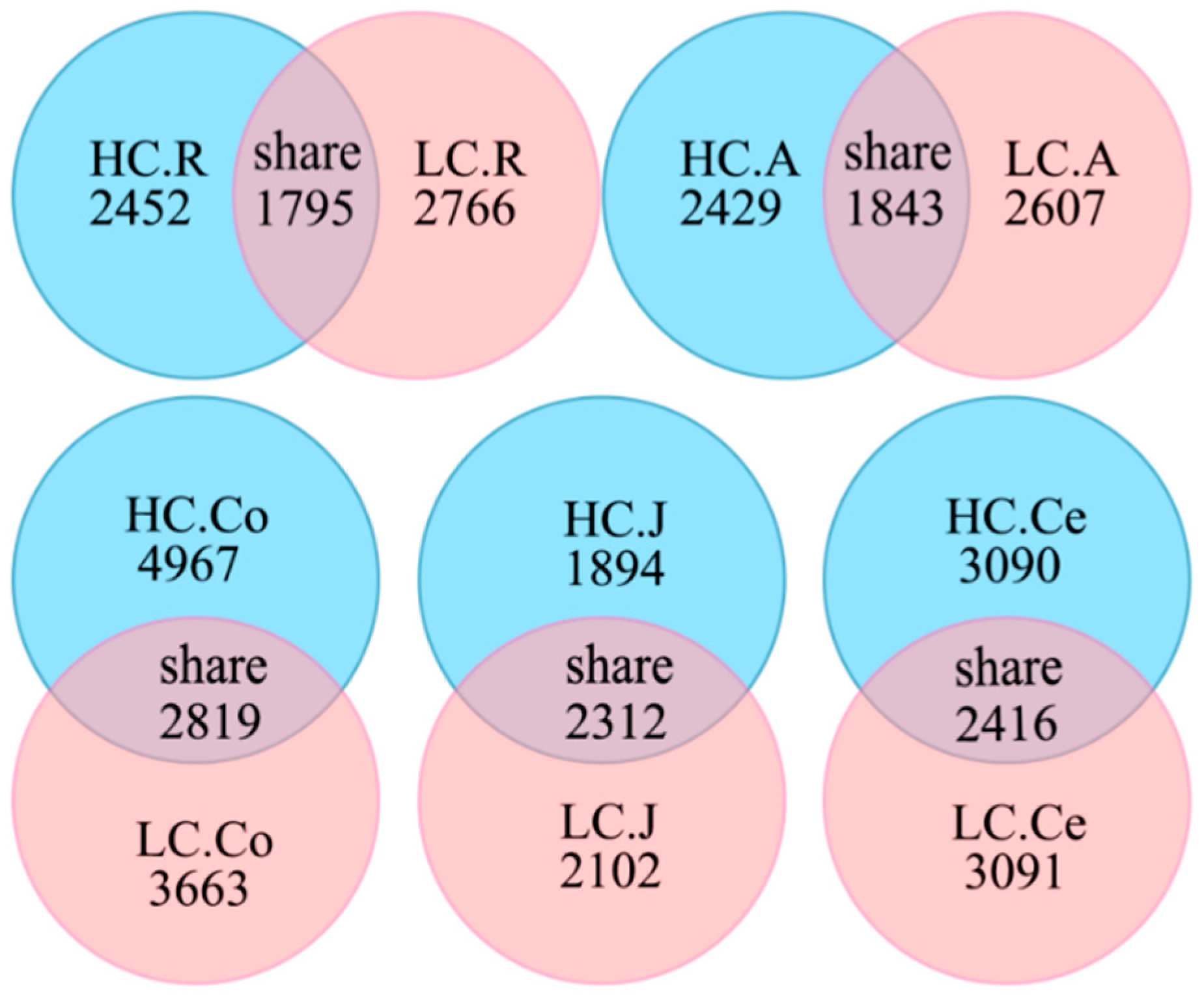
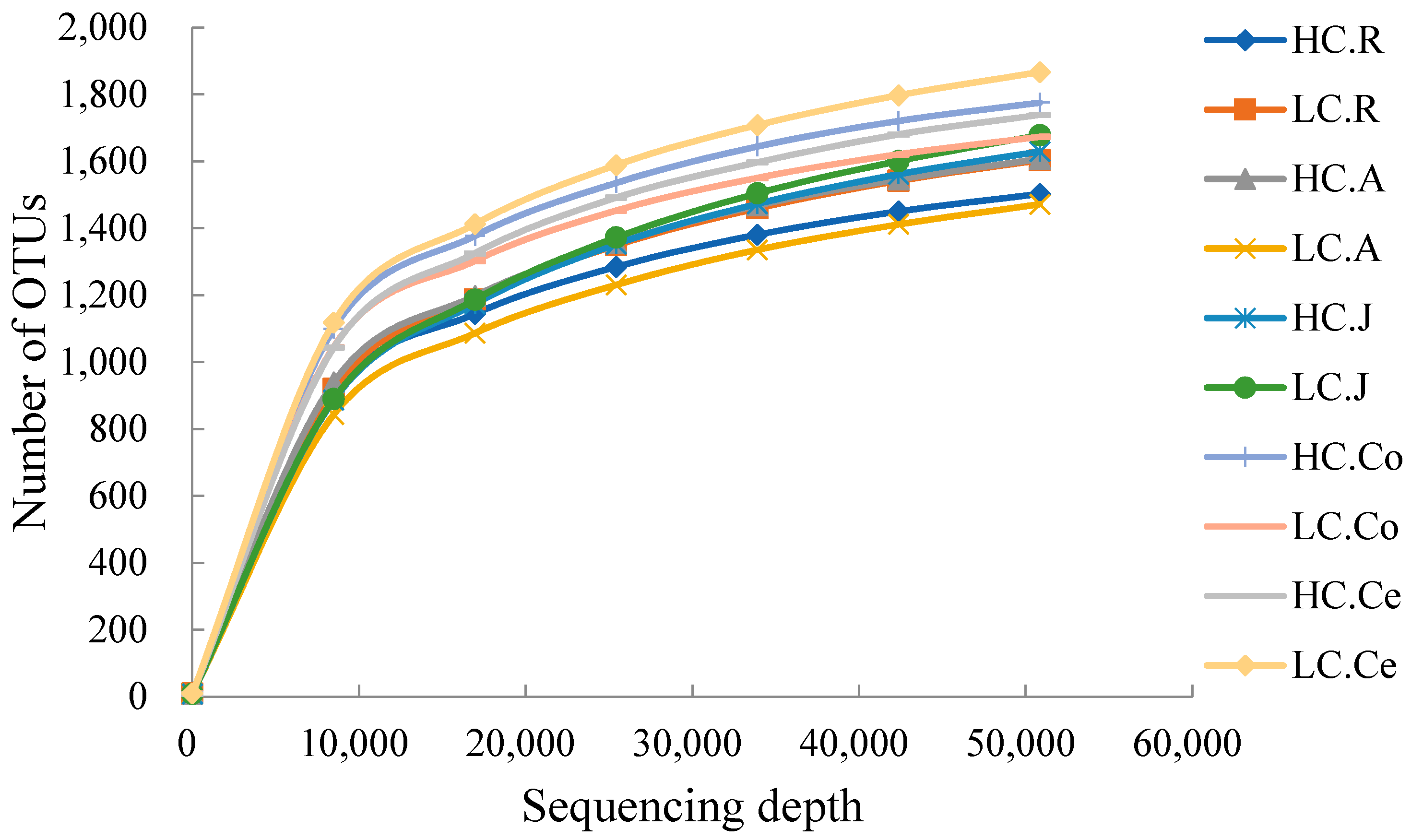
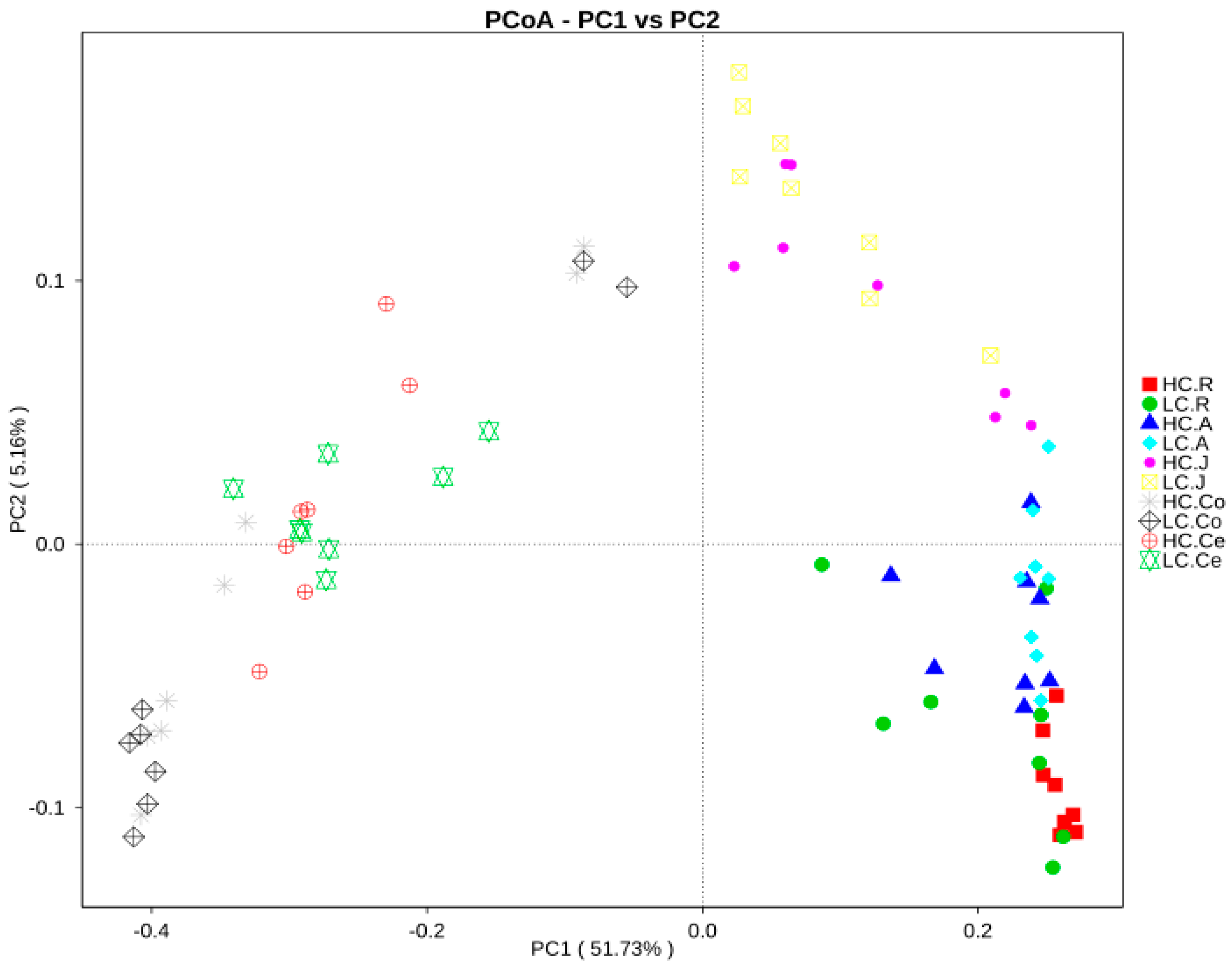
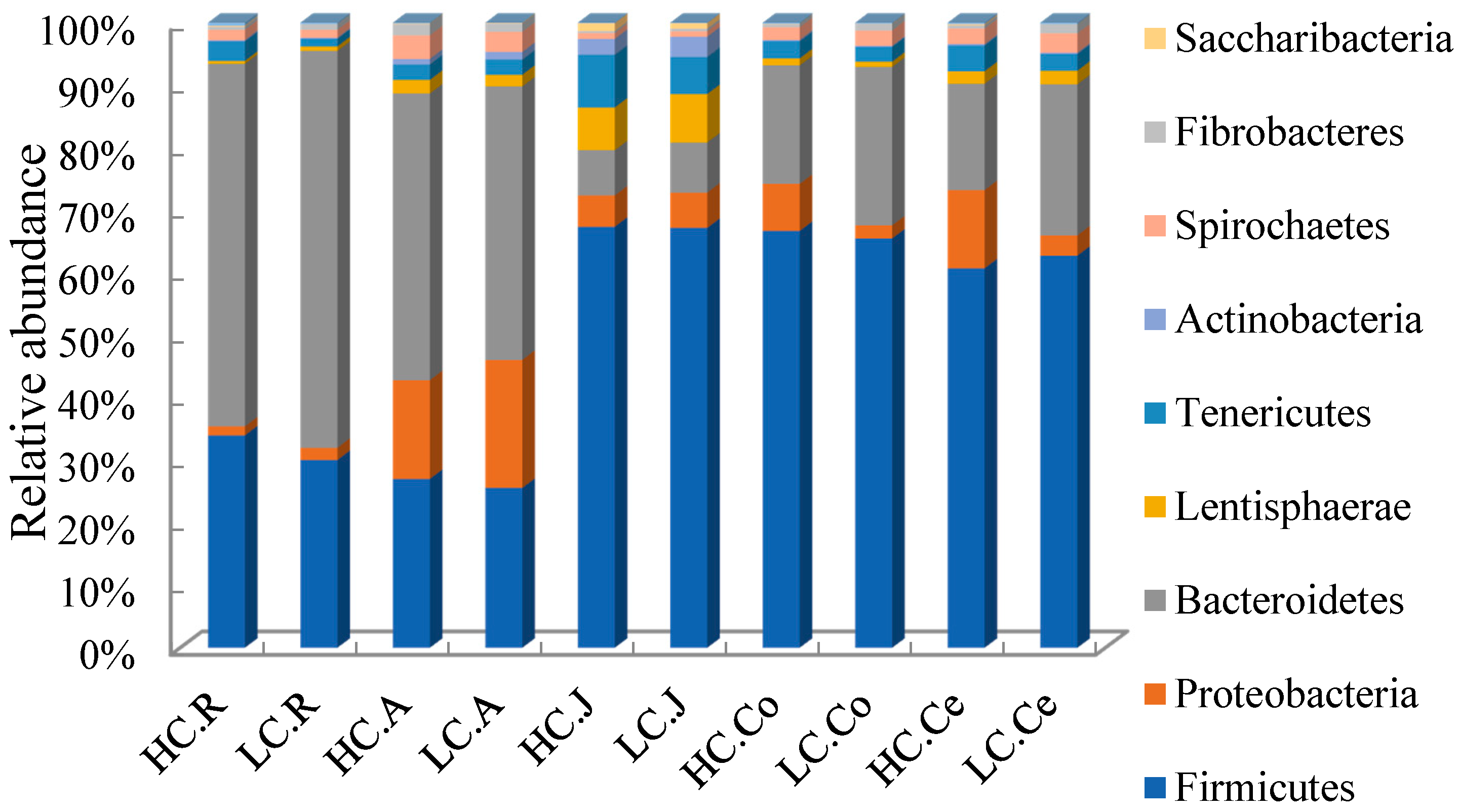
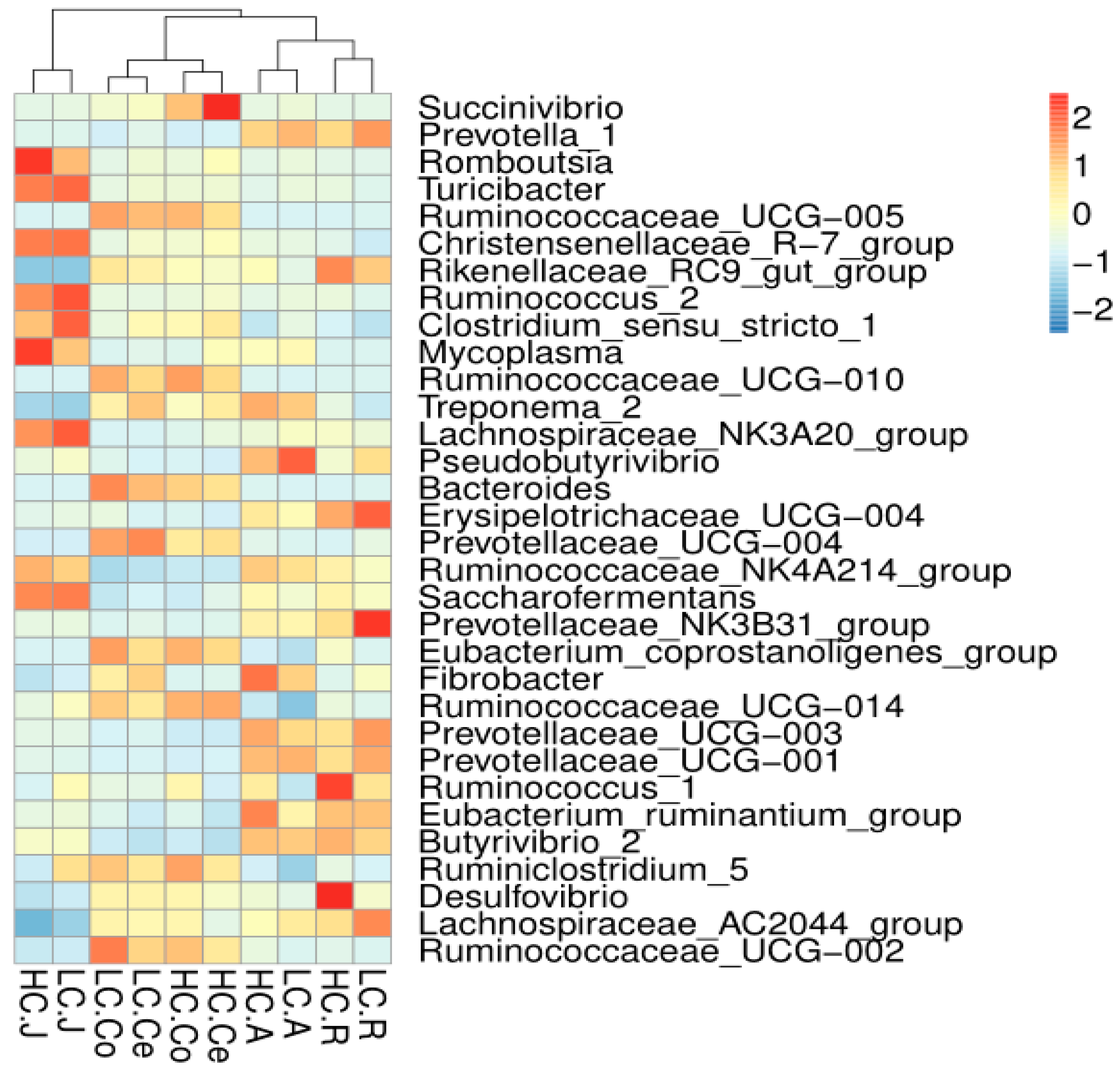

| Ingredients | Content (%) | |
|---|---|---|
| Stage | ||
| I | II | |
| Alfalfa meal | 20.00 | 20.00 |
| Leymus chinensis | 35.00 | 35.00 |
| Corn | 38.47 | 39.15 |
| Soybean meal | 4.50 | 4.50 |
| Premix 1 | 0.45 | 0.45 |
| NaCl | 0.45 | 0.45 |
| Baking soda | 0.45 | 0.45 |
| CaCO3 | 0.08 | - |
| CaHPO4 | 0.60 | - |
| Total | 100.00 | 100.00 |
| Nutrition levels 2 | ||
| Metabolic energy (ME) (MJ/kg) | 9.33 | 9.46 |
| Crude protein (CP) | 9.71 | 9.79 |
| Acid detergent fiber (ADF) | 24.07 | 24.07 |
| Neutral detergent fiber (NDF) | 36.11 | 36.20 |
| Calcium (calcium) | 0.52 | 0.35 |
| Phosphorus (P) | 0.33 | 0.22 |
| Ca/P | 1.58 | 1.59 |
| Items | HC (n = 8) | LC (n = 8) | p-Value |
|---|---|---|---|
| Serum parameters | |||
| calcium (mmol/L) | 2.35 ± 0.61 | 2.08 ± 0.50 | 0.230 |
| P (mmol/L) | 2.44 ± 0.61 | 2.33 ± 0.54 | 0.677 |
| Alkaline phosphatase of blood (U/L) | 204 ± 40.0 | 190 ± 71.8 | 0.644 |
| Rumen fermentation parameters | |||
| Rumen pH | 6.35 ± 0.24 | 6.40 ± 0.17 | 0.622 |
| Acetate (mmol/L) | 30.8 ± 4.64 | 33.2 ± 6.52 | 0.416 |
| Propionate (mmol/L) | 10.4 ± 1.97 | 10.5 ± 1.09 | 0.925 |
| Butyrate (mmol/L) | 7.99 ± 1.12 | 7.80 ± 1.69 | 0.791 |
| Acetate/Propionate | 3.00 ± 0.48 | 3.18 ± 0.70 | 0.553 |
| Apparent digestibility of nutrients (%) | |||
| Dry matter (DM) | 68.0 ± 1.96 | 69.0 ± 2.12 | 0.344 |
| Ash | 53.7 ± 3.65 | 56.2 ± 4.58 | 0.246 |
| Crude Protein (CP) | 45.6 ± 7.78 | 40.6 ± 12.4 | 0.352 |
| Ether extract (EE) | 67.8 ± 5.15 | 65.4 ± 4.68 | 0.345 |
| Acid detergent fiber (ADF) | 63.7 ± 3.01 | 62.9 ± 4.98 | 0.700 |
| Neutral detergent fiber (NDF) | 68.2 ± 2.13 | 70.1 ± 2.69 | 0.130 |
| Indices | Region | HC (n = 8) | LC (n = 8) | p-Value |
|---|---|---|---|---|
| Observed_species | Rumen | 1502.37 ± 62.77 | 1603.25 ± 177.37 | 0.152 |
| Abomasum | 1607.12 ± 105.13 | 1471.75 ± 142.00 | 0.048 | |
| Jejunum | 1629.25 ± 269.41 | 1678.12 ± 272.07 | 0.723 | |
| Colon | 1775.25 ± 323.41 | 1673.50 ± 314.31 | 0.534 | |
| Cecum | 1738.85 ± 316.67 | 1866.62 ± 174.17 | 0.342 | |
| Shannon | Rumen | 7.83 ± 0.49 | 7.69 ± 0.33 | 0.532 |
| Abomasum | 7.72 ± 0.48 | 7.27 ± 0.72 | 0.169 | |
| Jejunum | 6.81 ± 0.99 | 6.95 ± 1.05 | 0.787 | |
| Colon | 8.26 ± 0.83 | 8.36 ± 0.33 | 0.761 | |
| Cecum | 7.61 ± 2.03 | 8.28 ± 0.52 | 0.380 | |
| Simpson | Rumen | 0.98 ± 0.16 | 0.98 ± 0.09 | 0.883 |
| Abomasum | 0.97 ± 0.25 | 0.96 ± 0.25 | 0.581 | |
| Jejunum | 0.94 ± 0.40 | 0.96 ± 0.35 | 0.551 | |
| Colon | 0.97 ± 0.42 | 0.99 ± 0.04 | 0.336 | |
| Cecum | 0.92 ± 0.19 | 0.98 ± 0.07 | 0.307 | |
| Chao1 | Rumen | 1677.67 ± 102.15 | 1822.44 ± 202.62 | 0.093 |
| Abomasum | 1818.53 ± 106.48 | 1725.10 ± 147.06 | 0.168 | |
| Jejunum | 1848.95 ± 305.37 | 2003.67 ± 363.87 | 0.373 | |
| Colon | 1921.01 ± 368.73 | 1827.71 ± 341.88 | 0.608 | |
| Cecum | 1898.19 ± 308.03 | 2154.06 ± 232.38 | 0.090 | |
| ACE | Rumen | 1698.15 ± 74.93 | 1840.62 ± 196.68 | 0.076 |
| Abomasum | 1847.20 ± 124.26 | 1724.50 ± 140.05 | 0.085 | |
| Jejunum | 1897.47 ± 315.26 | 2028.63 ± 349.36 | 0.444 | |
| Colon | 1962.28 ± 396.48 | 1853.83 ± 373.81 | 0.582 | |
| Cecum | 1941.96 ± 315.68 | 2147.38 ± 214.70 | 0.160 | |
| Goods_Coverage | Rumen | 0.99 ± 0.00 | 0.99 ± 0.00 | 0.101 |
| Abomasum | 0.99 ± 0.00 | 0.99 ± 0.00 | 0.776 | |
| Jejunum | 0.99 ± 0.00 | 0.99 ± 0.02 | 0.365 | |
| Colon | 0.99 ± 0.00 | 0.99 ± 0.02 | 0.675 | |
| Cecum | 0.99 ± 0.00 | 0.99 ± 0.00 | 0.016 | |
| PD_Whole_Tree | Rumen | 81.80 ± 2.31 | 85.90 ± 6.42 | 0.111 |
| Abomasum | 88.44 ± 3.48 | 83.25 ± 5.66 | 0.045 | |
| Jejunum | 89.29 ± 11.97 | 106.42 ± 39.23 | 0.257 | |
| Colon | 84.08 ± 15.27 | 79.06 ± 15.33 | 0.523 | |
| Cecum | 83.83 ± 13.37 | 88.49 ± 7.17 | 0.407 |
| Level Region Taxa | Relative Abundance (%) | ||||
|---|---|---|---|---|---|
| HC | LC | p-Value | |||
| Phylum | R | Lentisphaerae | 0.441 ± 0.107 | 0.673 ± 0.251 | 0.031 |
| A | Chloroflexi | 0.413 ± 0.329 | 0.134 ± 0.058 | 0.033 | |
| Planctomycetes | 0.136 ± 0.077 | 0.033 ± 0.021 | 0.003 | ||
| Co | Bacteroidetes | 18.099 ± 4.901 | 24.224 ± 4.171 | 0.018 | |
| Fibrobacteres | 0.487 ± 0.411 | 1.060 ± 0.561 | 0.035 | ||
| Class | R | Clostridia | 26.996 ± 6.174 | 21.095 ± 0.1.724 | 0.021 |
| A | Negativicutes | 1.721 ± 0.576 | 1.073 ± 0.587 | 0.043 | |
| Anaerolineae | 0.412 ± 0.329 | 0.129 ± 0.049 | 0.031 | ||
| Planctomycetacia | 0.135 ± 0.076 | 0.033 ± 0.021 | 0.003 | ||
| Co | Bacteroidia | 17.908 ± 4.723 | 24.118 ± 4.191 | 0.015 | |
| Fibrobacteria | 0.486 ± 0.411 | 1.060 ± 0.561 | 0.035 | ||
| Order | R | Clostridiales | 26.996 ± 6.174 | 21.095 ± 1.723 | 0.021 |
| Saccharibacteria | 0.136 ± 0.072 | 0.048 ± 0.046 | 0.011 | ||
| A | Selenomonadales | 1.721 ± 0.575 | 1.074 ± 0.587 | 0.043 | |
| Anaerolineales | 0.412 ± 0.329 | 0.129 ± 0.049 | 0.031 | ||
| Planctomycetales | 0.135 ± 0.077 | 0.033 ± 0.021 | 0.003 | ||
| Co | Bacteroidales | 17.908 ± 4.723 | 24.118 ± 4.191 | 0.015 | |
| Fibrobacterales | 0.486 ± 0.411 | 1.060 ± 0.561 | 0.035 | ||
| Family | R | Ruminococcaceae | 10.051 ± 2.102 | 7.738 ± 1.551 | 0.025 |
| Prevotellaceae | 18.255 ± 3.445 | 25.758 ± 4.885 | 0.003 | ||
| Christensenellaceae | 2.132 ± 0.630 | 1.314 ± 0.386 | 0.007 | ||
| Bacteroidaceae | 0.081 ± 0.068 | 0.207 ± 0.145 | 0.044 | ||
| Saccharibacteria | 0.136 ± 0.072 | 0.048 ± 0.046 | 0.011 | ||
| Family_XIII | 0.995 ± 0.263 | 0.691 ± 0.123 | 0.011 | ||
| A | Rikenellaceae | 6.706 ± 1.832 | 4.409 ± 2.041 | 0.033 | |
| Acidaminococcaceae | 1.354 ± 0.446 | 0.820 ± 0.492 | 0.039 | ||
| Anaerolineaceae | 0.412 ± 0.329 | 0.129 ± 0.049 | 0.031 | ||
| Planctomycetaceae | 0.135 ± 0.076 | 0.033 ± 0.021 | 0.003 | ||
| Co | Ruminococcaceae | 4.125 ± 0.990 | 5.680 ± 1.287 | 0.017 | |
| Peptostreptococcaceae | 0.486 ± 0.411 | 1.060 ± 0.561 | 0.035 | ||
| Acidaminococcaceae | 0.315 ± 0.117 | 0.593 ± 0.339 | 0.046 | ||
| Genus | R | Prevotella_1 | 13.459 ± 3.370 | 18.619 ± 3.513 | 0.010 |
| Prevotellaceae_UCG-003 | 1.197 ± 0.256 | 1.718 ± 0.563 | 0.032 | ||
| Christensenellaceae_R-7_group | 2.071 ± 0.624 | 1.276 ± 0.384 | 0.008 | ||
| Pseudobutyrivibrio | 0.725 ± 0.252 | 1.833 ± 1.353 | 0.039 | ||
| Prevotellaceae_UCG-004 | 0.225 ± 0.111 | 0.411 ± 0.145 | 0.012 | ||
| Ruminococcus_2 | 0.612 ± 0.029 | 0.204 ± 0.069 | 0.002 | ||
| Quinella | 0.692 ± 0.571 | 0.213 ± 0.187 | 0.041 | ||
| Succinivibrionaceae_UCG-002 | 0.174 ± 0.187 | 0.539 ± 0.403 | 0.036 | ||
| Ruminococcaceae_UCG-004 | 0.218 ± 0.070 | 0.136 ± 0.054 | 0.021 | ||
| Bacteroides | 0.081 ± 0.068 | 0.207 ± 0.145 | 0.044 | ||
| Mogibacterium | 0.120 ± 0.033 | 0.065 ± 0.025 | 0.002 | ||
| Family_XIII_UCG-002 | 0.117 ± 0.038 | 0.061 ± 0.029 | 0.005 | ||
| Candidatus_Saccharimonas | 0.136 ± 0.072 | 0.048 ± 0.046 | 0.011 | ||
| Ruminococcaceae_UCG-007 | 0.100 ± 0.041 | 0.038 ± 0.027 | 0.003 | ||
| A | Rikenellaceae_RC9_gut_group | 6.191 ± 1.676 | 4.075 ± 1.951 | 0.035 | |
| Succiniclasticum | 1.351 ± 0.449 | 0.820 ± 0.492 | 0.041 | ||
| Ruminococcus_1 | 1.351 ± 0.449 | 0.820 ± 0.492 | 0.049 | ||
| Succinivibrio | 0.979 ± 0.265 | 0.649 ± 0.342 | 0.031 | ||
| Lachnospiraceae_NK3A20_group | 0.294 ± 0.172 | 0.804 ± 0.576 | 0.012 | ||
| Ruminococcaceae_UCG-014 | 0.550 ± 0.179 | 0.761 ± 0.101 | 0.012 | ||
| Lachnospiraceae_ND3007_group | 0.627 ± 0.232 | 0.361 ± 0.116 | 0.038 | ||
| Ruminococcaceae_UCG-010 | 0.658 ± 0.239 | 0.388 ± 0.230 | 0.026 | ||
| Eubacterium_coprostanoligenes_group | 0.536 ± 0.179 | 0.276 ± 0.141 | 0.006 | ||
| Acetitomaculum | 0.123 ± 0.066 | 0.218 ± 0.104 | 0.048 | ||
| Ruminococcaceae_UCG-004 | 0.199 ± 0.064 | 0.117 ± 0.070 | 0.029 | ||
| p-1088-a5_gut_group | 0.108 ± 0.066 | 0.031 ± 0.021 | 0.007 | ||
| Prevotellaceae_YAB2003_group | 0.037 ± 0.022 | 0.117 ± 0.088 | 0.026 | ||
| Co | Bacteroides | 4.125 ± 0.990 | 5.680 ± 1.287 | 0.017 | |
| Fibrobacter | 0.486 ± 0.410 | 1.059 ± 0.559 | 0.035 | ||
| Ruminiclostridium_1 | 0.161 ± 0.087 | 0.296 ± 0.135 | 0.033 | ||
| Ce | Butyrivibrio | 0.058 ± 0.015 | 0.125 ± 0.055 | 0.008 | |
© 2020 by the authors. Licensee MDPI, Basel, Switzerland. This article is an open access article distributed under the terms and conditions of the Creative Commons Attribution (CC BY) license (http://creativecommons.org/licenses/by/4.0/).
Share and Cite
Liu, Y.; Shah, A.M.; Wang, L.; Jin, L.; Wang, Z.; Xue, B.; Peng, Q. Relationship between the True Digestibility of Dietary Calcium and Gastrointestinal Microorganisms in Goats. Animals 2020, 10, 875. https://doi.org/10.3390/ani10050875
Liu Y, Shah AM, Wang L, Jin L, Wang Z, Xue B, Peng Q. Relationship between the True Digestibility of Dietary Calcium and Gastrointestinal Microorganisms in Goats. Animals. 2020; 10(5):875. https://doi.org/10.3390/ani10050875
Chicago/Turabian StyleLiu, Yuehui, Ali Mujtaba Shah, Lizhi Wang, Lei Jin, Zhisheng Wang, Bai Xue, and Quanhui Peng. 2020. "Relationship between the True Digestibility of Dietary Calcium and Gastrointestinal Microorganisms in Goats" Animals 10, no. 5: 875. https://doi.org/10.3390/ani10050875
APA StyleLiu, Y., Shah, A. M., Wang, L., Jin, L., Wang, Z., Xue, B., & Peng, Q. (2020). Relationship between the True Digestibility of Dietary Calcium and Gastrointestinal Microorganisms in Goats. Animals, 10(5), 875. https://doi.org/10.3390/ani10050875







